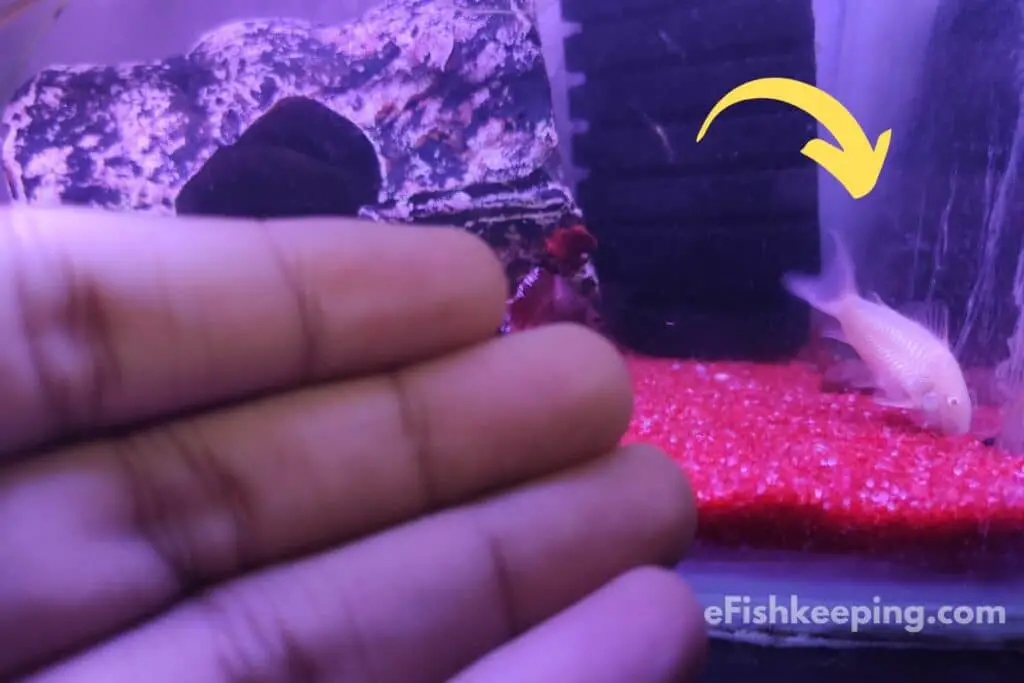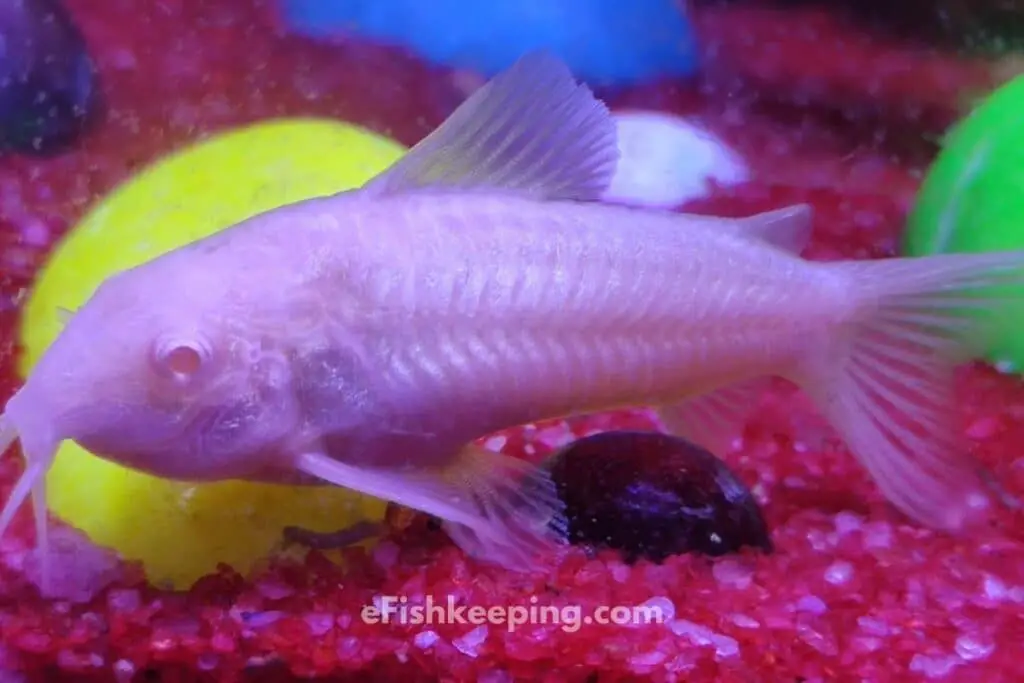Have a Cory Catfish that is turning white or pale? Then here’s what you need to know:
Cory catfish can turn white due to stress, especially when they are introduced to a new tank and there is a change in environment. However, there can also be other reasons for turning white, like illness, improper diet, or aging.
Read on till the end as I share all the possible reasons and their solutions so that you can solve the issue and ensure your cory catfish lives happily.

Reason-1: Cory Catfish Is Stressed
Did you get the Cory Catfish very recently from the pet store? Then it is likely turning white and losing its color to cope with the changing environment.
If an aquarium fish is under stress, it is not likely to show its optimal color. In some species of fish, a change in color of the integument is one of the visual indicators of stress.[1]
I have also noticed this even with fish in our home tanks. Although not specifically with cory catfish but with other fish.
“For instance, the last time, we got a batch of Glofish for our tank. As soon as we added them to the tank, a few turned pale and lost their color. But they were back in their original color within a day or two.”
Now stress in a fish can occur due to a variety of reasons as follows:
- Poor water quality
- Overcleaning the tank (doing too much or too large water changes)
- Inadequate nutrition
- Being moved
- Keeping them in a small tank. (Read more about the ideal tank size for cory catfish and how many cory catfish you should keep together)
- Tank is Overcrowded
- Tank Mates are Aggressive
Solution:
If you have just got the new cory catfish and it has turned white, give some time for it to settle with the new conditions. In most cases, the color should return to normal within a few days.
You should also check for the causes of stress in the tank. For example, are there any aggressive tank mates? Is the tank of enough size? Like that, you can brainstorm and ensure you are ticking all the boxes.
You can also watch this cory catfish care video to learn about the needed care:
Reason-2: Cory Catfish Is Sick
Another possible reason your cory catfish is turning white is that it is sick and suffering from an infection.
If you have a cory catfish for quite some time and suddenly start noticing it turning white, it is likely ill.

In general, the loss of color in a fish is one of the common symptoms of the fish going through bacterial infection, in addition to other symptoms.
For example, there is a fish disease called columnaris, which is caused by Flavobacterium columnare.[2] The bacterium of this disease can affect cultured, wild freshwater, and commercially important fish species.
The symptoms of columnaris disease are as follows:
- Grayish-white film on the skin
- Damaged fins
- Yellow to gray patches on gills
- Tissue on head eaten away
Also, some fungal and parasitic diseases can cause white patches or skin. So it’s important to know from the conditions your catfish is suffering.
Tip: You can pin or bookmark this page for later reference purposes
Here’s a chart that shows the common symptoms based on the type of infection in your fish:
| Infection Type: | Some Common Symptoms: |
| Bacterial | Loss of color, inactivity, bloated body, cloudy eyes, frayed fins, reddening or inflammation of the skin, struggling to breathe, bulging eyes. |
| Fungal | Swimming erratically, scratching, darting, cotton-like tufts on eyes, mouth, or skin |
| Parasitic | Inactivity, loss of appetite, rapid breathing, scratching, excess mucus or film on body, visible spots or worms. |
In case your cory catfish is not moving, you can check out my complete article about it here. And read this guide to know if your cory catfish is swimming like crazy.
Solution:
If your cory catfish is sick and suffering from some infection, you should first separate it in a separate quarantine tank.
A quarantine tank is a separate small tank used to treat weak or sick fish. It is good to separate the diseased fish from the tank and isolate them so they can’t spread the disease to other healthy fish in the tank.

If you don’t have a separate tank for this purpose, I recommend getting this one from Amazon.
Also, identify the cause of sickness in Cory Catfish. Is it a bacterial, fungal, or parasitic infection? Look at the symptoms, try to match, and see if you find the same symptoms in your Cory Catfish.
Once you know what caused the infection, you can apply the necessary treatment accordingly.
Note: Cory catfish are sensitive to salt. So that is something to keep in mind if you are thinking of using salt. In general, in a tank with cory catfish, you should use no more than 1 level teaspoon per gallon of water.
Reason-3: Cory Catfish Is Aging
Before I explain this reason, it is important to have a primary idea about fish coloration.
So the coloration in fish occurs by color pigments (Erithrin, Melanin, and Xanthin) that are mainly present in the cells known as Chromatophores.
Then, there are tiny reflective spheres in the skin, known as irridocytes. All the colors we observe in our freshwater fish are a mixture of these components.
Here are a few points to remember:
- If there is the absence of chromatophores in a fish, the fish will appear white.
- And the irridocytes in the fish are mainly responsible for the reflective properties.
- When the chromatophores of a fish are very dense, the color will also become dense.
Every fish is born with a fixed number of chromatophores which remains almost constant throughout the life of fish.
But the problem is as the fish goes through aging and its body grows; now those chromatophores have to cover a wider area of the skin. And therefore, in some fish, you will find them turning pale because the density of chromatophores is reducing.
Solution:
There is no solution to aging as it’s the natural process in the life cycle of your cory catfish. You just have to be aware that your cory catfish is likely growing older.
Usually, a fully grown male cory catfish is around 1-4 inches long. Females are typically longer than males and have wider bellies when we view them from the top.
Based on the cory catfish species, the males and females can live up to 5 years old.
Read this article to learn more about cory catfish lifespan and tips for increasing their lifespan.
Reason-4: Change In Diet If Cory Catfish
Usually, fish cannot make their own color pigment, so they take it from their diet. And an inadequate diet is one of the primary reasons that lead to color fading issues in a fish.
Solution:
Ensure your cory catfish are getting a high-quality diet, which will help them remain healthy and in their best colors.
Fish foods are supposed to have ingredients that are rich in carotenoids. So look at the fish food you are feeding and see its ingredients.

If you are looking for the best food for your Cory Catfish that would also ensure color enhancement, I highly recommend this food (available on Amazon). It has naturally occurring pigments known as beta carotenes which will help restore the true colors of your fish and make them vibrant.
Final Thoughts
In short, the most likely reason your cory catfish is turning white is due to stress or an underlying illness.
Fish are susceptible to stress occurring from changes in the environment. So if they have turned white just after you got them, there is nothing to panic about as they are likely stressed.
You can ensure all the tank conditions are adequate and leave them to settle on their own. They should be fine and return to their normal color within a few days.
However, don’t take it too lightly if the cory catfish show signs of illness, mainly infection symptoms. Isolate them in a quarantine tank and do proper treatment based on the infection.
And finally, if everything is fine, it could be the aging factor or diet factor causing the loss. I already suggested solutions for each cause earlier. So I hope you found this post helpful.
References:
- Conte, F. S. (2004). Stress and the welfare of cultured fish. Applied Animal Behaviour Science, 86(3-4), 205-223.
- Declercq AM, Haesebrouck F, Van den Broeck W, Bossier P, Decostere A. Columnaris disease in fish: a review with emphasis on bacterium-host interactions. Vet Res. 2013 Apr 24;44(1):27. doi: 10.1186/1297-9716-44-27. PMID: 23617544; PMCID: PMC3648355.
Hi! I’m Praveen Ghoshal, the founder of eFishkeeping.com. Inspired by my Dad, I got interested in fishkeeping when I was a kid. Since then, I have been involved with this hobby. Currently, I have 3 fish tanks at our home, and I enjoy this hobby with my full family. Read more about me here.





![Do Neon Tetras Die Easily? [Here’s The Truth!] do-neon-tetras-die-easily](https://efishkeeping.com/wp-content/uploads/2023/03/do-neon-tetras-die-easily-300x200.jpg)


